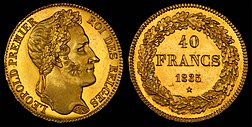Belgian Franc
| Belgian franc | |
|---|---|
|
Belgische frank (Dutch) Franc belge (French) Belgischer Franken (German) |
|

40 Belgian francs (1835)
|
|
| ISO 4217 | |
| Code | BEF |
| Denominations | |
| Subunit | |
| 1⁄100 |
Centime (French) Centiem (Dutch) Centime (German) |
| Plural |
Francs (French) Frank (Dutch) |
| Centime (French) Centiem (Dutch) Centime (German) |
Centimes (French) Centiemen (Dutch) |
| Symbol | fr. |
| Centime (French) Centiem (Dutch) Centime (German) |
c. |
| Banknotes | 100, 200, 500, 1000, 2000, 10,000 fr. |
| Coins | 50 centimes, 1, 5, 20 & 50 francs |
| Demographics | |
| User(s) | None, previously: |
| Issuance | |
| Central bank | National Bank of Belgium |
| Website | www |
| Printer | National Bank of Belgium |
| Website | www |
| Mint | National Bank of Belgium |
| Website | www |
| Valuation | |
| ERM | |
| Since | 13 March 1979 |
| Fixed rate since | 31 December 1998 |
| Replaced by €, non cash | 1 January 1999 |
| Replaced by €, cash | 1 January 2002 |
| € = | 40.3399 francs |
|
This infobox shows the latest status before this currency was rendered obsolete.
|
|
The Belgian franc (French: Franc belge, Dutch: Belgische frank, German: Belgischer Franken) was the currency of the Kingdom of Belgium from 1832 until 2002 when the Euro was introduced. It was subdivided into 100 subunits, known as centimes (French), centiem (Dutch) or Centime (German).
The conquest of most of western Europe by revolutionary and Napoleonic France led to the French franc's wide circulation. In the Austrian Netherlands (the current Belgium), the franc replaced the kronenthaler. This was in turn replaced by the Dutch guilder when the United Kingdom of the Netherlands was formed.
Following independence from the Kingdom of the Netherlands, the new Kingdom of Belgium in 1832 adopted its own franc, equivalent to the French franc, followed by Luxembourg in 1848 and Switzerland in 1850.
Belgian mint working during the late 19th century was innovative and Belgium was the first country to introduce coins made of cupronickel, in 1860.
In 1865, Belgium, France, Switzerland and Italy created the Latin Monetary Union (to be joined by Greece in 1868): each would possess a national currency unit (franc, lira, drachma) worth 4.5 g of silver or 290.322 mg of fine gold, all freely exchangeable at a rate of 1:1. In the 1870s the gold value was made the fixed standard, a situation which was to continue until 1914.
...
Wikipedia
